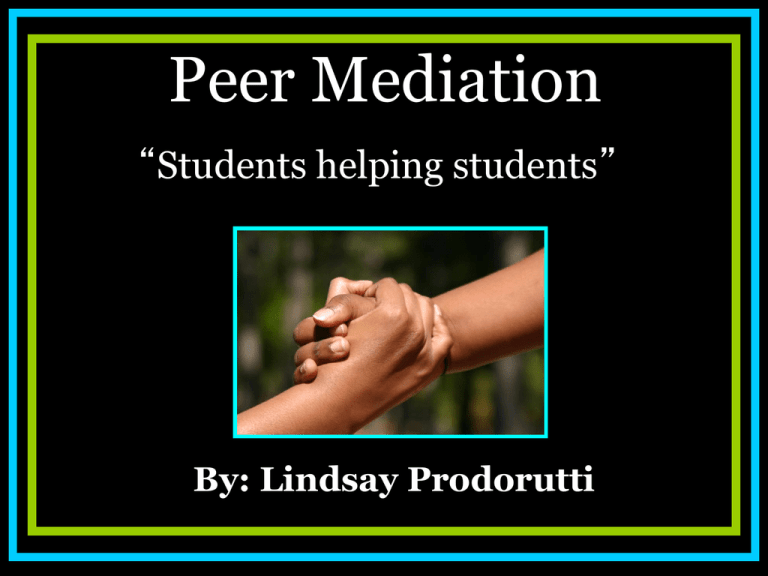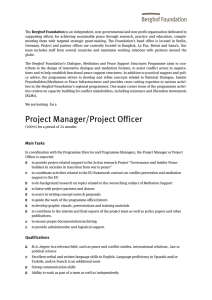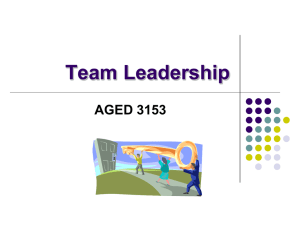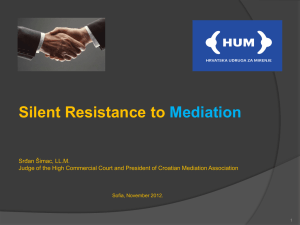Peer Mediation
advertisement

Peer Mediation “Students helping students” By: Lindsay Prodorutti What is Peer Mediation? Peer Mediation is a communication process in which the individuals with a problem work together, assisted by a neutral third party, to solve the problem. History of Peer Mediation Peer mediation programs started in the 1980’s Known as “Conflict Managers” Introduced by the San Francisco Community Board of Policy and Training Peer Mediation: Vocabulary Mediate: To intervene between two or more disputing parties in order to bring about an agreement Disputant: One engaged in an argument or conflict Ground Rule: One of the several basic rules for conducting peer mediation, spelled out to the disputants at the beginning of the session. Peer Mediation Mediation Process: Six Step Model Step #1: Agree to mediation (Request Form) Make introductions State ground rules Step #2: Gather information Ask each person to explain what happened Ask each person whether he or she wants to add anything Peer Mediation Mediation Process: Six Step Model Step #3: Focus on common interests Determine and summarize shared interests Step #4: Create options Brainstorm solutions and ask disputants what can be done to resolve the problem Peer Mediation Mediation Process: Six Step Model Step #5: Evaluate the options Ask each person what could be done to resolve the problem Step #6: Create an agreement Write up an agreement and have disputants sign it Shake hands Example of Peer Mediation Process: While watching the video: • High school setting • Watch how Sarah explains the student mediation process at her school • Peer Mediation Agreement Form: Documentation File Peer Mediation: A Process of Respect Peer Mediation Four Basic Principles: 1. Neutrality 2. Self-determination 3. Confidentiality 4. Voluntary Consent Peer Mediation Program Most widely used conflict resolution program in schools Conflict Resolution Tool Instead of disciplinary actions: Suspension & Detention Time-consuming role “Our school is a place where we can talk about our differences. We don’t have to fight to get justice.” Peer Mediation attacks the problem not the person. Who are the mediators? • Students (Sarah-Video) • 2-4 day training • Students can begin working with a peer mediation program as early as the 3rd grade • Develop skills: • Listening to both sides • Gaining trust • Identifying positions, issues, and interests • Building communication between parties • Dealing with emotions • Problem solving skills • Using settlement techniques Sample Peer Mediation Program Budget School A: Under $5,000 • Program team training (7 people @ $400) • Coordinator (faculty extracurricular pay) • Student training • Materials (30 student manuals) • Certificates • Operating expenses • Promotional materials • Forms and printing for ongoing training Total= $4,960 Sample Peer Mediation Program Budget School B: Over $40,000 • Program team training (7 people @ $400) • Full-time coordinator salary • Student training • Trainer consultation fee • Materials (30 student manuals) • Certificates • Operating expenses • Promotional materials • Forms and printing for ongoing training Total= $46,460 Hatboro-Horsham High School SAP Student Assistance Program Mission Statement: Students can confront, conquer or at least manage their problems with encouragement and support from: •HH SAP team •Faculty at HHHS •Mentor students & other HH students in groups “We don't always create the conflicts that enter our lives, but we can always choose our response to those conflicts” Hatboro-Horsham High School SAP Student Assistance Program Groups are based on the needs and desires of our students: •Self-Esteem •Anger Management •Men’s Group •Women’s Issues •Open Support • Family Issues •Grief and Loss •Decision Making • Drug & Alcohol •Diversity • New Students Group •Children from Divorced Families •Freshmen-Senior Mentor Group Classroom Implementation Mrs. Sanford’s 4th Grade Class Webpage: “I decided to introduce peer mediation in my classroom even though our school is not currently using this disciplinary method. I feel that it will help to create a trusting and respectful community. It is my hope that discipline problems will be minimal so that we can spend our time working and solving problems that are curriculum based.” Webpage provides: • Scenarios • Videos • Forms • Training Peer Mediation Results •Peer mediation programs are very successful when students are trained effectively-58%-93% of the time success was achieved. Success is measured if agreement was reached and maintained •A 36% reduction of school wide general disruptive behavior, this includes fighting, verbal abuse, and arguments •Two studies have shown that peer mediation has reduced 75% of the occurrences of suspensions What kinds of disputes can be mediated? Misunderstandings between students Teasing or name-calling Relationship arguments Accusations of theft or destruction of property Rumors and/or fights between groups Group Activity Jocks, Nerds, Bullies, Popular Crowd, Teacher’s Pet Scenario Lauren: Ever since you wouldn’t let your friend Melissa copy the answers to your math test, Melissa has been writing threatening e-mails to you and spreading rumors about you to your friends. It’s been two weeks and you’re tired of putting up with it. You start spreading rumors about her and pranking her cell phone. The next day, Melissa is waiting for you after school, ready to fight. Question: Instead of retaliating, what do you think Lauren should have done to resolve the problem? Peer Mediation: As a group discuss the Advantages/Disadvantages of Peer Mediation. Have you ever witnessed/experienced Peer Mediation during grade school? Peer Mediation Advantages: Disadvantages: Resolves student conflicts Privacy Teaches students essential life skills Motivates students to resolve their conflicts collaboratively Increases selfesteem Improves school climate Meets needs of both students and educators Student cooperation Students are embarrassed Process of training peer mediators References Schrumpf, F. (1997). Peer Mediation: Conflict Resolution in Schools. Illinois: Research Press. Bodine,R. J. & Crawford, D. K. (1998). The handbook of conflict resolution education: A guide to building quality programs in schools. San Francisco: JosseyBass. Johnson, D.W.,& Johnson,R. T. (1996). Conflict resolution and peer mediation programs in elementary and secondary schools: A review of the research. Review of Educational Research. Peer Mediation. Study Guides and Strategies. Retrieved November 22, 2011, from http://www.studygs.net/peermed.htm.






